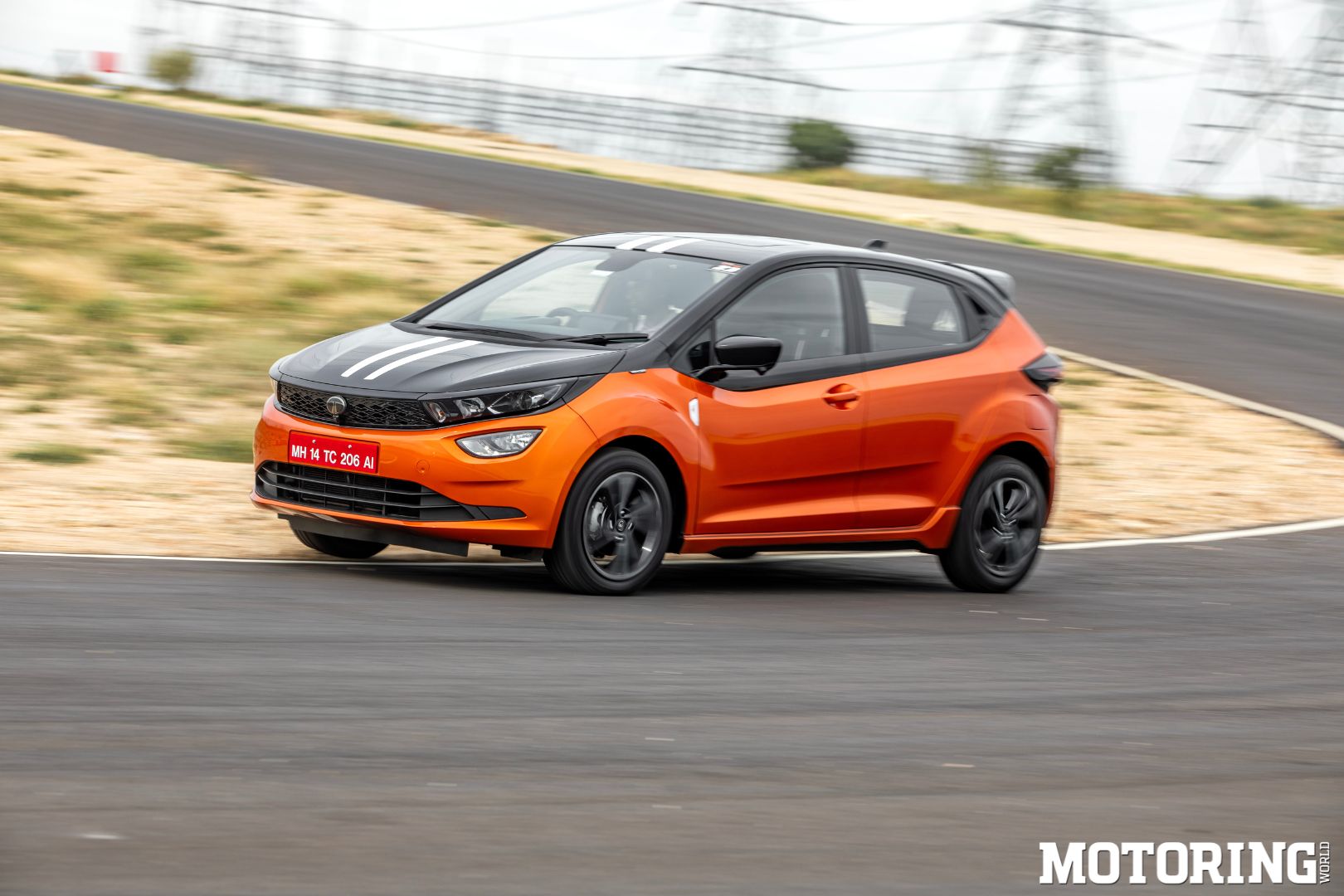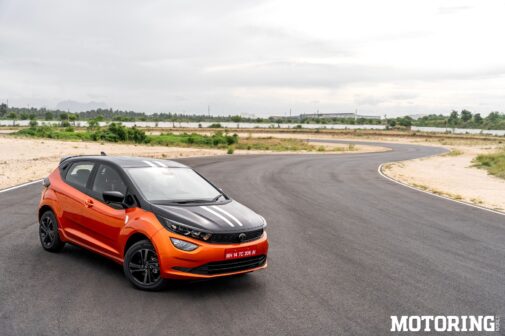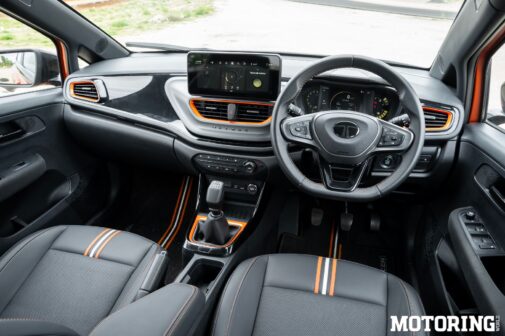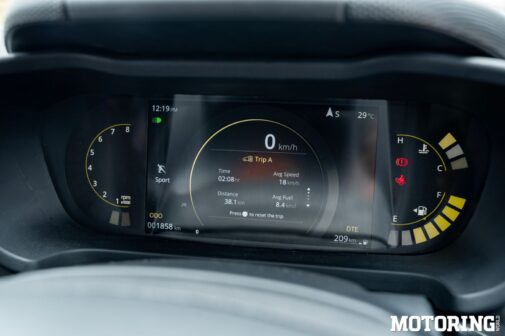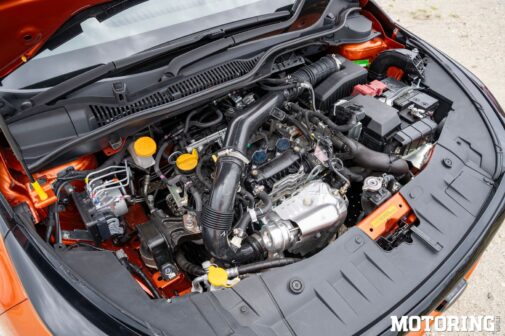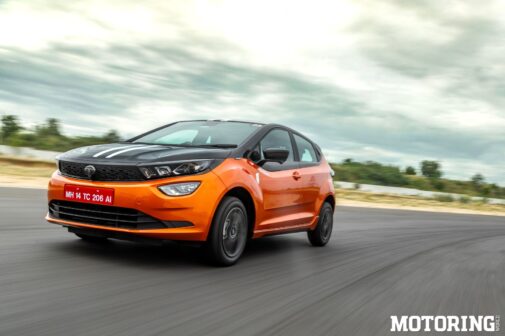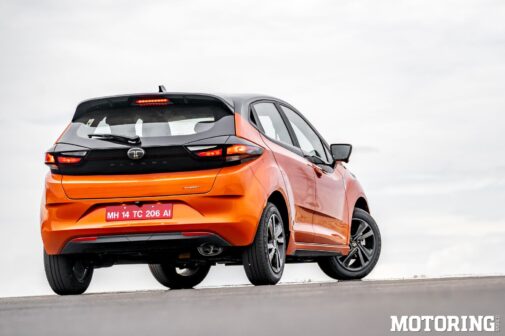Allow me to begin with a disclaimer: if you’re looking for the definitive, in-depth, every-detail review of the Tata Altroz Racer, you’ve probably come to the wrong place. You’ll know everything about the car that I believe you need to after you read this story, mind you, but that will be a somewhat tangential occurrence. Since this issue’s special theme is the visual aspect of the automotive world, what I will largely tell you about is the act of driving a car at a racetrack, since that’s amongst a petrolhead’s most sought-after experiences.
Now, the Racer likely won’t be the first car that comes to mind when you’re hankering after a track day – but it’ll certainly put its hand up confidently. Almost a 100 per cent of this car’s life will be spent in the everyday traffic I described earlier, this much is guaranteed; however, that doesn’t mean it’s content with the humdrum. Visually, it’s the Altroz we all know, but the pizazz it now comes with does give it a hot hatch personality. It’s not a car that screams its intentions from the rooftops; rather, it winks at the world of performance. The three new two-tone paint schemes – black and grey, black and orange, black and white – definitely add a touch of visual intrigue, without being over the top (the black and grey is my pick of the lot).
The addition of a discreet rear spoiler is a functional flourish; other than these, you’ll see ‘Racer’ badging, sill cladding, racing stripes on the bonnet and roof and a twin-tip exhaust can. Tata Motors has the Hyundai i20 N Line squarely in its sights, and it must be said that the Racer is off to a good start in the looks department.
Inside, the transformation is more pronounced. Slide into the redesigned, two-tone cabin and you’re greeted by leatherette sports seats with cool racing stripes – and the front seats are ventilated, a segment-first (but only in the range-topping R3 variant). They add a touch of unexpected luxury to this performance-oriented package, and work very well, too; in fact, they cool your posterior so quickly that I had to turn the ventilation off, for fear of icicle formation.
The new digital instruments look very good, displaying all the important information in a clear manner, and the new infotainment screen (off the Punch EV) is equally hi-res; it comes with Tata’s connected car tech, iRA, which allows you to do the usual connected car things. Tata has made every effort to stuff the Racer with features – wireless charging, cruise control, a sunroof, rear A/C vents, 360-degree camera et al – and it’s unlikely you’ll find yourself wanting more of them, if you get yourself the R3 version. As always, there’s plenty of room in this cabin, and there’s a real sense of good, old-fashioned solidity to it (6 airbags are standard, too) save for some of the plastics, which look and feel downmarket.
This would be ‘all show, no go’ if not for the Nexon’s 1.2-litre, 3-pot turbo-petrol engine, which finds a new home under the Altroz’s bonnet. The power and torque outputs are unchanged – 118 bhp and 17.3 kgm; they’re also almost exactly the same as what the i20 N Line puts out, so Tata Motors isn’t being subtle about its intentions with the car. There’s a new 6-speed manual gearbox paired to a new hydraulic clutch, and this combination is the only one on sale at the moment.
Thumb the starter button and the Racer settles into a steady thrum; you can definitely hear the louder exhaust note. The clutch is likely to catch you off guard when you want to get things moving, because it has a very snappy bite to it; this takes getting used to, and in dense traffic it can be a bit of a legful. In these conditions, the engine/gearbox combination is sorted enough to potter around; you won’t find yourself having to constantly change gears, since the torque spread is broad. As an everyday car, therefore, the Racer is very useable, and its slow-speed ride quality is excellent; I would certainly have no problem using it as a daily runabout. Out on the highway, the steering wheel weighs up very nicely at higher speeds, since it’s been tuned for this, and triple-digit cruising is a breeze.
However, we’re going to talk about racetracks, since Tata Motors decided that the best place to showcase the car’s capabilities was the new CoASTT High Performance Centre, just outside Coimbatore. A racetrack literally alters your world-view. Everyday driving (especially in this country) throws a smorgasbord of sights, sounds and smells at you – other road users, animals, lights, horns, fumes and so on – which means your brain is constantly processing all of this in real time. Setting out alone on a racetrack wipes that slate clean, and presents you with… repetition. Suddenly, your windscreen isn’t cluttered with wildly different visuals, and you see the exact same things over and over again, forcing you to go into tunnel-vision mode, where laser-focus is key; you have to very quickly memorise every turn, incline, slope, bump and dip, so that ultimately all you’re doing is <I>driving<I>. Your mind and body have to be willing partners in this endeavour, reaching a state of precise cooperation in order to place the tyres just so, reel off those lap times and flick your car into tyre-smoking slides.
All of which the Racer is capable of, by the way. Narain Karthikeyan helped in its development and was at the track, giving us hacks effortless hot laps in the car and casually explaining its handling characteristics while launching it into corners. He mentioned that the suspension had been very mildly tuned, resulting in a touch more sharpness in it; this was amply made visible during both the hot laps and my own time behind the wheel.
While no F1 rocket, the Racer was surprisingly assured around the CoASTT track, displaying an eagerness to play that I didn’t expect; it went where I pointed it, with the steering wheel showing plenty of accuracy, and the snappy clutch suddenly wasn’t a problem, since it lent itself to quick shifts with the smooth, short-throw gearbox. There was very little body roll, and overcooking corners didn’t upset the car in the way I imagined it would. The power delivery from the engine was satisfyingly linear, too, and the Racer never felt out of breath during my 15-odd laps around the fast, flowing circuit.
There’s a certain poetry to driving like this, I found. The track was essentially a canvas, glistening starkly against the horizon, awaiting my brushstrokes – the dance of rubber on tarmac, the blur of the scenery as I gunned it, the guttural symphony of an internal combustion engine at full chat. It was a stage, too, where the mundane act of driving was elevated to an art form, a pursuit of precision and speed. It shrinks your world considerably – the familiar hum of everyday traffic is replaced by a blur of colour, punctuated by the rhythmic flashing of the kerbs. It’s a sensory feast, but also a strangely meditative experience.
At the end of my time with it, I found that the most pleasing aspect of the Racer lies in its ability to transform your perspective, despite it not attempting to be the ultimate track weapon. One minute you’re navigating the mundane realities of everyday traffic, the next you’re cocooned in a microcosm of speed and focus. It’s a reminder that even within the confines of our daily routines, there’s room for a touch of exhilaration, a chance to reconnect with the simple joy of driving. It’s not a car that screams for attention, but it’s one that rewards a discerning driver with a subtly enhanced experience; indeed, even someone without any track experience will find the Racer a very friendly car in which to gain some.
Ultimately, the Altroz Racer is a compelling proposition for the enthusiast on a budget; it injects a dash of spice into the daily commute, while offering surprising track capabilities. Sure, there are minor quibbles. The new hydraulic clutch, while perfectly suited for track heroics, is a bit too snappy in slow-moving city traffic. Getting used to it is a small price to pay for the on-track prowess, but this is a heads-up for potential buyers. The MRF tyres, while adequate for everyday driving, lack the kind of razor-sharp grip a true track rat might crave. Finally, the interior plastics, while functional, feel a touch downmarket compared to some rivals. These points are, however, outweighed by the satisfaction of driving this feisty little car, and the fact that it’s cheaper than the i20 N Line is a bonus. It isn’t a true hot hatch, because there aren’t any in this country, but it succeeds at raising the temperature in the segment, which is a win by itself.
AUTODATA
Tata Altroz RacerPOWERTRAIN
Displacement:
Max Power:
Max Torque:
Transmission:
1199cc, three-cyl, turbo-petrol
118.2bhp@5500 rpm
17.33 kgm@1750-4500rpm
6-speed manual
TYRES
F/R: 185/60 R16
DIMENSIONS
L/W/H (mm):
Wheelbase:
Ground Clearance:
Kerb Weight:
Fuel Capacity:
3990/1755/1523
2501 mm
165 mm
1056 kg
37 litres
PRICE
Rs 9.49 lakh to Rs 10.99 lakh (ex-showroom, India)





